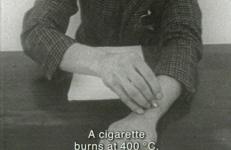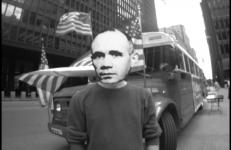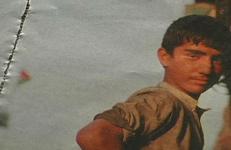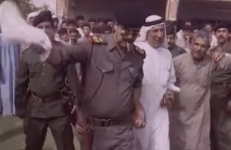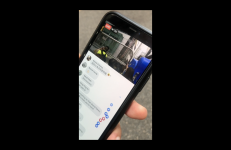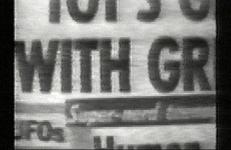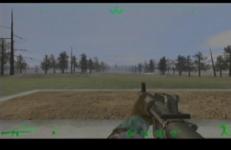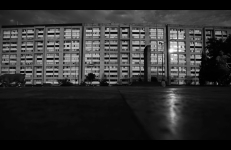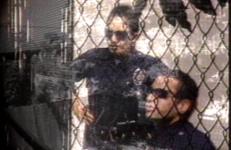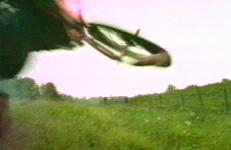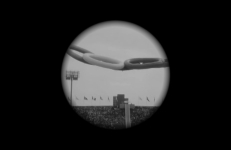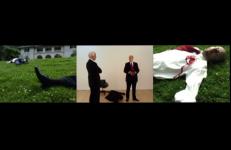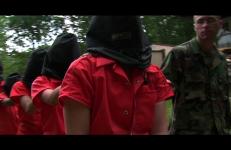"When we show you pictures of napalm victims, you'll shut your eyes. You'll close your eyes to the pictures. Then you'll close them to the memory. And then you'll close your eyes to the facts." These words are spoken at the beginning of this agitprop film that can be viewed as a unique and remarkable development. Farocki refrains from making any sort of emotional appeal. His point of departure is the following: "When napalm is burning, it is too late to extinguish it. You have to fight napalm where it is produced: in the factories."
Crime or Violence
Found-footage video that addresses American racism and the violence that it spawns.
A queer rewriting of the events surrounding the 1968 National Democratic Convention in Chicago from the point of view of French writer Jean Genet. Along the way Genet will meet, amongst others, Allen Ginsberg, William S. Burroughs, the Yippies, the Black Panther Party and the Chicago police force... Ultimately, the video is about the difficulty of aligning political and sexual desires.
A man learns his daughter has been brutally murdered by her husband. Time stands still as he oscillates between the need for solace and his urge for revenge. La Bouche is an experimental musical featuring Guinean percussion master Mohamed Bangoura (“Red Devil”), loosely based on his own story.
Letters, conversations: New York-Chicago, Fall, 2001 is driven by a fragmented voice-over that criss-crosses between two female voices – one seemingly formal and distant, the other more conversational and intimate. It begins with short excerpts from emails, phone conversations and letters between friends, family, ex-lovers and acquaintances in the days and weeks following September 11th, 2001.
Two women occupy one space. Without showing their faces, the camera lingers on their bodies in images that capture both from an extreme high angle. The camera distorts the female body, even creating a grotesque effect. A voice repeatedly calls for a woman: “Lisa, come here, don’t be afraid… that’s it, I won’t hurt you.” A video which explores the gaze on the female body, and the desires and violence overwhelming it.
This title is also available on Hester Scheurwater Videoworks: Volume 1.
Loss Prevention combines documentary and fiction to tell the story of Irene, arrested at the age of 79 for stealing a bottle of aspirin from a Miami Wal-Mart and sentenced to ten weeks of Senior Citizen Shoplifting Prevention School. Narrated through the voice of her daughter, this film explores the alienation of aging and the evolving relationship between a daughter and an elderly mother.
Love Songs #1 is composed of three pieces that pose questions about urban culture, race, and politics. Found footage images are manipulated and juxtaposed with popular music; the effects are unsettling, ironic, and sometimes humorous.
After an all-night session of editing Free Society, Garrin headed home with video-8 camera in-hand, only to happen upon the Tompkins Square riots. As police tried to enforce a curfew aimed at removing homeless people from the park, Garrin began gathering footage of cops beating up protesters. He was then attacked by police himself, as the camera continued to roll. The footage was subsequently incorporated into Free Society, in which the military myth of "protect and serve" is dismantled by first-hand experience.
Despite assurances from local municipalities, a fact of life is that Manholes blow sky high more frequently than most people realize. Manhole 452 directs the viewer’s attention to the shapes, sizes and patterns of manhole covers on Geary Street in San Francisco, and then plunges deep below into the manholes themselves to explore the hidden threat that lies below.
Despite assurances from local municipalities, a fact of life is that Manholes blow sky high more frequently than most people realize. Manhole 452 directs the viewer’s attention to the shapes, sizes and patterns of manhole covers on Geary Street in San Francisco, and then plunges deep below into the manholes themselves to explore the hidden threat that lies below.
Taped on Prince Street in Soho, New York City, Skip Blumberg creates a one-word performance. Shouting the word "money" over and over, he attracts the attention of New York's finest. The video crew attempt to explain to the policemen that there is no public disorder as the streets were empty when they began to tape.
The video is an unwitting early example of the reaction of the state to the use of video cameras on the streets.
Through dancing, The Motherfucker's Birthday shows the evil of the dictator and the horror people endure under powerful political leaders. The film presents dancing, a universal and uniquely human activity often representing joy, with eerie footage of Saddam and his sons’ torture tools while they dance. Bush also dances with a smirk across the screen while announcing a war that would destabilize a whole region.
A sound-essay set in the Tallahatchie County Second District Courtroom in Sumner, Mississippi, mythicPotentialities is an exploration of the event said to have galvanized the civil rights movement in America, the murder of Emmett Till, the trial that followed, and the way these event have been mediated through documentary text like Eyes on the Prize, The Murder of Emmet Till, and numerous other books, plays, poems and articles.
The Nazi-Loop ponders the horror of the Holocaust and the social diseases that characterized it: ethnocentrism, xenophobia, and anti-semitism. Images and text from Weimar and Nazi Germany are woven into a complex montage, which includes representations of contemporary neo-Nazism and those who oppose it. Also woven in are essays by social thinkers that reflect upon the meaning of the historical horror of the Holocaust. The Nazi-Loop suggests that the obsessive ethnocentrism, xenophobia, and anti-Semitism of past times and places is cyclical and present, here and now.
Never Rest/Unrest is a hand-held short film about the relentless political actions in Hong Kong, spanning early summer to late 2019. The experimental short is an adaptation of the artist's practice of scaling oral history, utilizing the vertical 16:9 aspect ratio as a vernacular form. Never Rest/Unrest takes up the provocation of Julio Garcia Espinosa's "Imperfect Cinema" on the potential for filmmaking that aims towards an urgent, process-driven cinema. Dominant narratives of crisis pushed by news journalism are resisted.
In a version of the “teenage diary,” Benning places her feelings of confusion and depression alongside grisly tales from tabloid headlines and brutal events in her neighborhood. The difficulty of finding a positive identity for oneself in a world filled with violence is starkly revealed by Benning’s youthful but already despairing voice.
This title is also available on Sadie Benning Videoworks: Volume 1.
A combination of experimental and narrative approaches which explore the commodification of rebellion as it is marketed to youth culture, through the eyes of two drug-dealing, teenage girls from Brooklyn who "accidentally" kill and mutilate their favorite alternative rock star. Their obsession with murders and makeovers and their confusion between fashion and transgression lead these girls into a world where nihilism is bought and sold, and rebellion is impossible.
O.U.T. is a work documenting the emergence of computer games which train players to fight in cities among civilians, (Military Operations in Urban Terrain). O.U.T. contains sampled footage and machinima (stories told with video games) from five military simulation games. Following is a documentation of the performance, (Operation Urban Terrain), an urban wireless intervention by Anne-Marie Schleiner and an international cast of game expert and art activist collaborators.
A voice for which an event impossible to internalize remains distant. An event that in its distance does not cease to make the narration of something that should not take place anywhere foreign. The military massacre against unarmed students in 1968.
This video highlights several narratives concerning video surveillance—not to reiterate the conventional privacy argument but rather to engage the desire to watch surveillance materials and society’s insatiable voyeurism. A variety of subjects recount their interactions with surveillance—getting caught in the act of stealing or watching pornography, being discouraged from making an illegal ATM withdrawal—and question technological determinism, asking whether we choose to develop technology or technology shapes our choices.
Juxtaposing the text of Off Limits, a film made in 1987 about Saigon circa 1968, with the soundtrack and image of the last five minutes of Easy Rider, made in 1968, Tajiri parallel edits these representations to play with the evocation and emptiness of the image. Tajiri blacks out the screen image of Easy Rider while the words of a Vietnamese assassin crawl up the screen, building a structure of selective memory. Tajiri’s Off Limits points to the similarities and contradictions between 1960s hippie iconography and memories of the Vietnam War.
1968 was the opening of the Summer Olympics in Mexico City, ten days after the massacre of students and civilians by military and police on October 2 in the "Plaza de las Tres Culturas, Tlatelolco."
The Only Ones Left (three-channel video installation*), featuring actor Jim Fletcher, weaves film noir and mafia genre references with CEO diatribes, while also exposing the conventions of the feature film climax. The three channels of video depict all plot points of the Hollywood film climax concurrently. The channels are arranged chronologically from left to right. This simultaneity draws attention to the familiarity of the subject matter and the inevitability of the violent consequences awaiting the characters.
Operation Atropos is a documentary about interrogation and POW resistance training. Director Coco Fusco worked with retired U.S. Army interrogators who subjected her group of women students to immersive simulations of POW experiences in order to show them what hostile interrogations can be like and how members of the U.S. military are taught to resist them. The group of interrogators is called Team Delta, and they regularly offer intensive courses that they call "Authentic Military Experiences" to civilians.




